1. Principal Activities, Organisation and Basis of Presentation
Principal activities
China Telecom Corporation Limited (the “Company”) and its subsidiaries (hereinafter, collectively referred to as the “Group”) offers a comprehensive range of wireline and mobile telecommunications services including wireline voice, mobile voice, Internet, telecommunication network resource services and lease of network equipment, value-added services, integrated information application services and other related services. The Group provides wireline telecommunications services and related services in Beijing Municipality, Shanghai Municipality, Guangdong Province, Jiangsu Province, Zhejiang Province, Anhui Province, Fujian Province, Jiangxi Province, Guangxi Zhuang Autonomous Region, Chongqing Municipality, Sichuan Province, Hubei Province, Hunan Province, Hainan Province, Guizhou Province, Yunnan Province, Shaanxi Province, Gansu Province, Qinghai Province, Ningxia Hui Autonomous Region and Xinjiang Uygur Autonomous Region of the People’s Republic of China (the “PRC”). Following the acquisition of Code Division Multiple Access (“CDMA”) mobile telecommunications business in October 2008, the Group also provides mobile telecommunications and related services in the mainland China and Macau Special Administrative Region (“Macau”) of the PRC. The Group also provides international telecommunications services, including lease of network equipment, International Internet access and transit, and Internet data centre service in certain countries of the Asia Pacific, Europe, Africa, South America and North America regions. The operations of the Group in the mainland China are subject to the supervision and regulation by the PRC government.
Organisation
As part of the reorganisation (the “Restructuring”) of China Telecommunications Corporation, the Company was incorporated in the PRC on 10 September 2002. In connection with the Restructuring, China Telecommunications Corporation transferred to the Company the wireline telecommunications business and related operations in Shanghai Municipality, Guangdong Province, Jiangsu Province and Zhejiang Province together with the related assets and liabilities (the “Predecessor Operations”) in consideration for 68,317 million ordinary domestic shares of the Company. The shares issued to China Telecommunications Corporation have a par value of RMB1.00 each and represented the entire registered and issued share capital of the Company at that date.
On 31 December 2003, the Company acquired the entire equity interests in Anhui Telecom Company Limited, Fujian Telecom Company Limited, Jiangxi Telecom Company Limited, Guangxi Telecom Company Limited, Chongqing Telecom Company Limited and Sichuan Telecom Company Limited (collectively the “First Acquired Group”) and certain network management and research and development facilities from China Telecommunications Corporation for a total purchase price of RMB46,000 million (hereinafter, referred to as the “First Acquisition”).
On 30 June 2004, the Company acquired the entire equity interests in Hubei Telecom Company Limited, Hunan Telecom Company Limited, Hainan Telecom Company Limited, Guizhou Telecom Company Limited, Yunnan Telecom Company Limited, Shaanxi Telecom Company Limited, Gansu Telecom Company Limited, Qinghai Telecom Company Limited, Ningxia Telecom Company Limited and Xinjiang Telecom Company Limited (collectively the “Second Acquired Group”) from China Telecommunications Corporation for a total purchase price of RMB27,800 million (hereinafter, referred to as the “Second Acquisition”).
On 30 June 2007, the Company acquired the entire equity interests in China Telecom System Integration Co., Ltd. (“CTSI”), CT Global and China Telecom (Americas) Corporation (“CT Americas”) (collectively the “Third Acquired Group”) from China Telecommunications Corporation for a total purchase price of RMB1,408 million (hereinafter, referred to as the “Third Acquisition”).
On 30 June 2008, the Company acquired the entire equity interest in China Telecom Group Beijing Corporation (“Beijing Telecom” or the “Fourth Acquired Company”) from China Telecommunications Corporation for a total purchase price of RMB5,557 million (hereinafter, referred to as the “Fourth Acquisition”).
On 1 August 2011 and 1 December 2011, the subsidiaries of the Company, E-surfing Pay Co., Ltd and E-surfing Media Co., Ltd., acquired the e-commerce business and video media business (collectively the “Fifth Acquired Group”) from China Telecommunications Corporation and its subsidiaries for a total purchase price of RMB61 million (hereinafter, referred to as the “Fifth Acquisition”). The Company disposed the equity interest in E-surfing Media Co., Ltd. to China Telecommunications Corporation in 2013.
On 30 April 2012, the Company acquired the digital trunking business (the “Sixth Acquired Business”) from Besttone Holding Co., Ltd., a subsidiary of China Telecommunications Corporation, at a purchase price of RMB48 million (hereinafter, referred to as the “Sixth Acquisition”).
On 31 December 2013, the subsidiary of the Company, CT Global acquired 100% equity interest in China Telecom (Europe) Limited (“CT Europe” or the “Seventh Acquired Company”), a wholly owned subsidiary of China Telecommunications Corporation, from China Telecommunications Corporation for a total purchase price of RMB278 million (hereinafter, referred to as the “Seventh Acquisition”), and was paid by 30 June 2014.
Hereinafter, the First Acquired Group, the Second Acquired Group, the Third Acquired Group, the Fourth Acquired Company, the Fifth Acquired Group, the Sixth Acquired Business and the Seventh Acquired Company are collectively referred to as the “Acquired Groups”.
Basis of presentation
Since the Group and the Acquired Groups are under common control of China Telecommunications Corporation, the Group’s acquisitions of the Acquired Groups have been accounted for as a combination of entities under common control in a manner similar to a pooling-of-interests. Accordingly, the assets and liabilities of these entities have been accounted for at historical amounts and the consolidated financial statements of the Group prior to the acquisitions are combined with the financial statements of the Acquired Groups. The considerations for the acquisition of the Acquired Groups are accounted for as an equity transaction in the consolidated statement of changes in equity.
Merger with subsidiaries
Pursuant to the resolution passed by the Company’s shareholders at an extraordinary general meeting held on 25 February 2008, the Company entered into merger agreements with each of the following subsidiaries: Shanghai Telecom Company Limited, Guangdong Telecom Company Limited, Jiangsu Telecom Company Limited, Zhejiang Telecom Company Limited, Anhui Telecom Company Limited, Fujian Telecom Company Limited, Jiangxi Telecom Company Limited, Guangxi Telecom Company Limited, Chongqing Telecom Company Limited, Sichuan Telecom Company Limited, Hubei Telecom Company Limited, Hunan Telecom Company Limited, Hainan Telecom Company Limited, Guizhou Telecom Company Limited, Yunnan Telecom Company Limited, Shaanxi Telecom Company Limited, Gansu Telecom Company Limited, Qinghai Telecom Company Limited, Ningxia Telecom Company Limited and Xinjiang Telecom Company Limited. In addition, the Company entered into merger agreements with Beijing Telecom on 1 July 2008. Pursuant to these merger agreements, the Company merged with these subsidiaries and the assets, liabilities and business operations of these subsidiaries were transferred to the Company’s branches in the respective regions.
2. Disposal of Certain Telecommunications Towers and Related Assets
On 11 July 2014, the Company, China United Network Communications Corporation Limited (“CUCL”) and China Mobile Communication Company Limited entered into an agreement to establish China Tower. Pursuant to the agreement, the Company, CUCL and China Mobile Communication Company Limited each subscribed for 2.99 billion shares, 3.01 billion shares and 4.00 billion shares of the China Tower, respectively in cash at a par value of RMB1.00 per share, representing a shareholding percentage of 29.9%, 30.1% and 40.0%, respectively. The China Tower primarily engages in the construction, maintenance and operation of telecommunications towers, and also engages in the construction, maintenance and operation of ancillary facilities such as control rooms, power supply systems and air conditioning systems of base stations, etc. and indoor distribution systems as well as the provision of outsourcing maintenance services for base station equipment.
On 14 October 2015, the Company, China Mobile Communication Company Limited and related subsidiaries (together, “China Mobile”), CUCL and Unicom New Horizon Telecommunications Company Limited (together, “China Unicom”), China Reform Holding Company Limited (“CRHC”) and China Tower entered into a transfer agreement (the “Transfer Agreement”). Pursuant to the Transfer Agreement, the Company sold certain telecommunications towers and related assets (“Tower Assets”) to China Tower (hereinafter referred to as “Tower Assets Disposal”) and injected cash to China Tower in return for new shares (the “Consideration Shares”) issued by China Tower. China Mobile and China Unicom also sold certain telecommunications towers and related assets to China Tower in return for new shares issued by China Tower and for cash; and CRHC made cash subscription for new shares issued by China Tower.
The Tower Assets Disposal was completed on 31 October 2015 (“Completion Date”). The final consideration amount of the Tower Assets Disposal was determined as RMB30.131 billion. China Tower issued 33.097 billion Consideration Shares to the Company at an issue price of RMB1.00 per share under the Transfer Agreement in return for the Tower Assets and RMB2.966 billion cash (“Cash Consideration”) from the Company. The Cash Consideration was paid in February 2016.
Upon the issuance of the Consideration Shares by China Tower, the Company, China Unicom, China Mobile and CRHC hold 27.9%, 28.1%, 38.0% and 6.0% of the share capital of China Tower, respectively.
The Tower Assets Disposal was recognised as an assets disposal. The Company realised a gain (subject to deduction of relevant expenses and taxes) from the Tower Assets Disposal, which was calculated based on the surplus of the final consideration amount for the Tower Assets Disposal over the book value of the Tower Assets as at the Completion Date as set out below. As the Company held 27.9% of the share capital of China Tower, only 72.1% of the aforesaid gain was recognised at the Completion Date and the remaining 27.9% of the aforesaid gain is deferred over the remaining useful life of the Tower Assets.
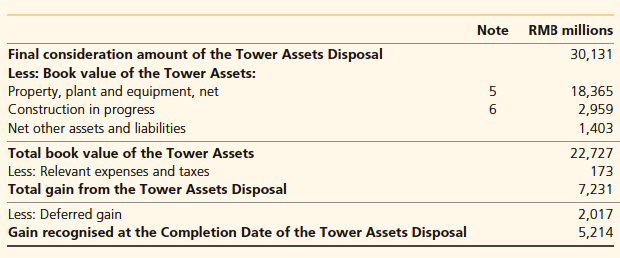
3. Significant Accounting Policies
(a) Basis of preparation
The accompanying consolidated financial statements have been prepared in accordance with International Financial Reporting Standards (“IFRS”) as issued by the International Accounting Standards Board (“IASB”). The consolidated financial statements also comply with the disclosure requirements of the Hong Kong Companies Ordinance and the applicable disclosure provisions of the Rules Governing the Listing of Securities on The Stock Exchange of Hong Kong Limited.
The provisions of the new Hong Kong Companies Ordinance (Cap 622) regarding the preparation of accounts and audit report became effective for the Group for the financial year ended 31 December 2015. The disclosure requirements set out in the Rules Governing Listing of Securities on The Stock Exchange of Hong Kong Limited (“Listing Rules”) regarding annual accounts have been amended with reference to the new Hong Kong Companies Ordinance. Accordingly, the presentation and disclosure of information in the consolidated financial statements for the financial year ended 31 December 2015 have been changed to comply with these new requirements. Comparative information in respect of the financial year ended 31 December 2014 are presented or disclosed in the consolidated financial statements based on the new requirements. Information previously required to be disclosed under the predecessor Hong Kong Companies Ordinance or Listing Rules but not under the new Hong Kong Companies Ordinance or amended Listing Rules are not disclosed in the consolidated financial statements.
The consolidated financial statements are prepared on the historical cost basis as modified by the revaluation of certain available-for-sale equity securities at fair value (Note 3(l)).
The preparation of consolidated financial statements in conformity with IFRS requires management to make judgements, estimates and assumptions that affect the application of policies and the reported amounts of assets and liabilities and disclosure of contingent assets and liabilities at the date of the consolidated financial statements and the reported amounts of revenues and expenses during the reporting period. The estimates and associated assumptions are based on historical experience and various other factors that management believes are reasonable under the circumstances, the results of which form the basis of making the judgments about carrying values of assets and liabilities that are not readily apparent from other sources. Actual results may differ from those estimates.
The estimates and underlying assumptions are reviewed on an ongoing basis. Revisions to accounting estimates are recognised in the period in which the estimate is revised if the revision affects only that period or in the period of the revision and future periods if the revision affects both current and future periods.
Judgements made by management in the application of IFRS that have significant effect on the consolidated financial statements and major sources of estimation uncertainty are discussed in Note 42.
(b) Basis of consolidation
The consolidated financial statements comprise the Company and its subsidiaries and the Group’s interests in associates.
A subsidiary is an entity controlled by the Company. When fulfilling the following conditions, the Company has control over an entity: (a) has power over the investee, (b) has exposure, or rights, to variable returns from its involvement with the investee, and (c) has the ability to use its power over the investee to affect the amount of the investor’s returns.
When assessing whether the Company has power over that entity, only substantive rights (held by the Company and other parties) are considered.
The financial results of subsidiaries are included in the consolidated financial statements from the date that control commences until the date that control ceases, and the profit attributable to non-controlling interests is separately presented on the face of the consolidated statement of comprehensive income as an allocation of the profit or loss for the year between the non-controlling interests and the equity holders of the Company. Non-controlling interests represent the equity in subsidiaries not attributable directly or indirectly to the Company. For each business combination, the Group measures the non-controlling interests at the proportionate share, of the acquisition date, of fair value of the subsidiary’s net identifiable assets. Non-controlling interests at the end of the reporting period are presented in the consolidated statement of financial position within equity and consolidated statement of changes in equity, separately from the equity of the Company’s equity holders. Changes in the Group’s interests in a subsidiary that do not result in a loss of control are accounted for as equity transactions, whereby adjustments are made to the amounts of controlling and noncontrolling interests within consolidated equity to reflect the change in relative interests, but no adjustments are made to goodwill and no gain or loss is recognised. When the Group loses control of a subsidiary, it is accounted for as a disposal of the entire interest in that subsidiary, with a resulting gain or loss being recognised in profit or loss. Any interest retained in that former subsidiary at the date when control is lost is recognised at fair value and this amount is regarded as the fair value on initial recognition of a financial asset or, when appropriate, the cost on initial recognition of an investment in an associate or a joint venture.
An associate is an entity, not being a subsidiary, in which the Group exercises significant influence, but not control, over its management. Significant influence is the power to participate in the financial and operating policy decisions of the investee but is not control or joint control over those policies.
An investment in an associate is accounted for in the consolidated financial statements under the equity method and is initially recorded at cost, adjusted for any excess of the Group’s share of the acquisition-date fair values of the investee’s net identifiable assets over the cost of the investment (if any) after reassessment. Thereafter, the investment is adjusted for the Group’s equity share of the post-acquisition changes in the associate’s net assets and any impairment loss relating to the investment. When the Group ceases to have significant influence over an associate, it is accounted for as a disposal of the entire interest in that investee, with a resulting gain or loss being recognised in profit or loss. Any interest retained in that former investee at the date when significant influence is lost is recognised at fair value and this amount is regarded as the fair value on initial recognition of a financial asset.
All significant intercompany balances and transactions and unrealised gains arising from intercompany transactions are eliminated on consolidation. Unrealised gains arising from transactions with associates are eliminated to the extent of the Group’s interest in the entity. Unrealised losses are eliminated in the same way as unrealised gains, but only to the extent that there is no evidence of impairment.
(c) Foreign currencies
The accompanying consolidated financial statements are presented in Renminbi (“RMB”). The functional currency of the Company and its subsidiaries in mainland China is RMB. The functional currency of the Group’s foreign operations is the currency of the primary economic environment in which the foreign operations operate. Transactions denominated in currencies other than the functional currency during the year are translated into the functional currency at the applicable rates of exchange prevailing on the transaction dates. Foreign currency monetary assets and liabilities are translated into the functional currency using the applicable exchange rates at the end of the reporting period. The resulting exchange differences, other than those capitalised as construction in progress (Note 3(i)), are recognised as income or expense in profit or loss. For the periods presented, no exchange differences were capitalised.
When preparing the Group’s consolidated financial statements, the results of operations of the Group’s foreign operations are translated into RMB at average rate prevailing during the year. Assets and liabilities of the Group’s foreign operations are translated into RMB at the foreign exchange rates ruling at the end of the reporting period. The resulting exchange differences are recognised in other comprehensive income and accumulated separately in equity in the exchange reserve.
(d) Cash and cash equivalents
Cash and cash equivalents comprise cash at bank and in hand and time deposits with original maturities of three months or less when purchased. Cash equivalents are stated at cost, which approximates fair value. None of the Group’s cash and cash equivalents is restricted as to withdrawal.
(e) Accounts and other receivables
Accounts and other receivables are initially recognised at fair value and thereafter stated at amortised cost using the effective interest method, less allowance for doubtful debts (Note 3(n)) unless the effect of discounting would be immaterial, in which case they are stated at cost less allowance for doubtful debts.
(f) Inventories
Inventories consist of materials and supplies used in maintaining the telecommunications network and goods for resale. Inventories are valued at cost using the specific identification method or the weighted average cost method, less a provision for obsolescence.
Inventories are stated at the lower of cost or net realisable value. Net realisable value is the estimated selling price in the ordinary course of business less the estimated costs of completion, the estimated costs to make the sale and the related tax expenses.
(g) Property, plant and equipment
Property, plant and equipment are initially recorded at cost, less subsequent accumulated depreciation and impairment losses (Note 3(n)). The cost of an asset comprises its purchase price, any directly attributable costs of bringing the asset to working condition and location for its intended use and the cost of borrowed funds used during the periods of construction. Expenditure incurred after the asset has been put into operation, including cost of replacing part of such an item, is capitalised only when it increases the future economic benefits embodied in the item of property, plant and equipment and the cost can be measured reliably. All other expenditure is expensed as it is incurred.
Assets acquired under leasing agreements which effectively transfer substantially all the risks and benefits incidental to ownership from the lessor to the lessee are classified as assets under finance leases. Assets held under finance leases are initially recorded at amounts equivalent to the lower of the fair value of the leased assets at the inception of the lease or the present value of the minimum lease payments (computed using the rate of interest implicit in the lease). The net present value of the future minimum lease payments is recorded correspondingly as a finance lease obligation. Assets held under finance leases are amortised over their estimated useful lives on a straight-line basis. As at 31 December 2015, no asset was held by the Group under finance leases (2014: RMB18 million).
Gains or losses arising from retirement or disposal of property, plant and equipment are determined as the difference between the net disposal proceeds and the carrying amount of the respective asset and are recognised as income or expense in the profit or loss on the date of disposal.
Depreciation is provided to write off the cost of each asset over its estimated useful life on a straight-line basis, after taking into account its estimated residual value, as follows:

Where parts of an item of property, plant and equipment have different useful lives, the cost of the item is allocated on a reasonable basis between the parts and each part is depreciated separately. Both the useful life of an asset and its residual value are reviewed annually.
(h) Lease prepayments
Lease prepayments represent land use rights paid. Land use rights are initially carried at cost or deemed cost and then charged to profit or loss on a straight-line basis over the respective periods of the rights which range from 20 years to 70 years.
(i) Construction in progress
Construction in progress represents buildings, telecommunications network plant and equipment and other equipment and intangible assets under construction and pending installation, and is stated at cost less impairment losses (Note 3(n)). The cost of an item comprises direct costs of construction, capitalisation of interest charge, and foreign exchange differences on related borrowed funds to the extent that they are regarded as an adjustment to interest charges during the periods of construction. Capitalisation of these costs ceases and the construction in progress is transferred to property, plant and equipment and intangible assets when the asset is substantially ready for its intended use.
No depreciation is provided in respect of construction in progress.
(j) Goodwill
Goodwill represents the excess of the cost over the Group’s interest in the fair value of the net assets acquired in the CDMA business (as defined in Note 7) acquisition.
Goodwill is stated at cost less any accumulated impairment losses. Goodwill is allocated to cash-generating units and is tested annually for impairment (Note 3(n)). On disposal of a cash generating unit during the year, any attributable amount of the goodwill is included in the calculation of the profit or loss on disposal.
(k) Intangible assets
The Group’s intangible assets are computer software.
Computer software that is not an integral part of any tangible assets, is recorded at cost less subsequent accumulated amortisation and impairment losses (Note 3(n)). Amortisation of computer software is calculated on a straight-line basis over the estimated useful lives, which mainly range from three to five years.
(l) Investments
Investments in available-for-sale equity securities are carried at fair value with any change in fair value being recognised in other comprehensive income and accumulated separately in equity. For investments in available-for-sale equity securities, a significant or prolonged decline in the fair value of that investment below its cost is considered to be objective evidence of impairment. When these investments are derecognised or impaired, the cumulative gain or loss previously recognised in other comprehensive income is recognised in profit or loss. Investments in unlisted equity securities that do not have a quoted market price in an active market and whose fair value cannot be reliably measured are stated at cost less impairment losses (Note 3(n)).
(m) Operating lease charges
Where the Group has the use of assets held under operating leases, payments made under the leases are charged to profit or loss in equal installments over the accounting periods covered by the lease term, except where an alternative basis is more representative of the pattern of benefits to be derived from the leased asset. Lease incentives received are recognised in profit or loss as an integral part of the aggregate net lease payments made. Contingent rentals are charged to profit or loss in the accounting period in which they are incurred.
(n) Impairment
(i) Impairment of accounts and other receivables and investments in equity securities carried at costAccounts and other receivables and investments in equity securities carried at cost are reviewed at the end of each reporting period to determine whether there is objective evidence of impairment. Objective evidence of impairment includes observable data that comes to the attention of the Group about one or more of the following loss events:
– significant financial difficulty of the debtor or issuer;
– a breach of contract, such as a default or delinquency in interest or principal payments;
– it becoming probable that the debtor will enter bankruptcy or other financial reorganisation; and
– significant changes in the technological, market, economic or legal environment that have an adverse effect on the debtor/issuer.
The impairment loss for accounts and other receivables is measured as the difference between the asset’s carrying amount and the estimated future cash flows, discounted at the financial asset’s original effective interest rate where the effect of discounting is material, and is recognised as an expense in profit or loss.
The impairment loss for investments in equity securities carried at cost is measured as the difference between the asset’s carrying amount and the estimated future cash flows, discounted at the current market rate of return for a similar financial asset where the effect of discounting is material, and is recognised as an expense in profit or loss.
Impairment losses for accounts and other receivables are reversed through profit or loss if in a subsequent period the amount of the impairment losses decreases. Impairment losses for equity securities carried at cost are not reversed.
(ii) Impairment of long-lived assetsThe carrying amounts of the Group’s long-lived assets, including property, plant and equipment, intangible assets with finite useful lives and construction in progress are reviewed periodically to determine whether there is any indication of impairment. These assets are tested for impairment whenever events or changes in circumstances indicate that their recorded carrying amounts may not be recoverable. For goodwill, the impairment testing is performed annually at each year end.
The recoverable amount of an asset or cash-generating unit is the greater of its fair value less costs of disposal and value in use. When an asset does not generate cash flows largely independent of those from other assets, the recoverable amount is determined for the smallest group of assets that generates cash inflows independently (i.e. a cashgenerating unit). In determining the value in use, expected future cash flows generated by the assets are discounted to their present value using a pre-tax discount rate that reflects current market assessments of time value of money and the risks specific to the asset for which the estimates of future cash flows have not been adjusted. The goodwill arising from a business combination, for the purpose of impairment testing, is allocated to cash-generating units that are expected to benefit from the synergies of the combination.
An impairment loss is recognised if the carrying amount of an asset or its cash-generating unit exceeds its estimated recoverable amount. Impairment loss is recognised as an expense in profit or loss. Impairment loss recognised in respect of cash-generating units is allocated first to reduce the carrying amount of any goodwill allocated to the units and then to reduce the carrying amounts of the other assets in the unit (group of units) on a pro rata basis.
The Group assesses at the end of each reporting period whether there is any indication that an impairment loss recognised for an asset in prior years may no longer exist. An impairment loss is reversed if there has been a favourable change in the estimates used to determine the recoverable amount. A subsequent increase in the recoverable amount of an asset, when the circumstances and events that led to the write-down cease to exist, is recognised as an income in profit or loss. The reversal is reduced by the amount that would have been recognised as depreciation and amortisation had the write-down not occurred. An impairment loss in respect of goodwill is not reversed. For the years presented, no reversal of impairment loss was recognised in profit or loss.
(o) Revenue recognition
The revenue recognition methods of the Group are as follows:
(i) Revenue derived from local, domestic long distance and international, Hong Kong, Macau and Taiwan long distance usage are recognised as the services are provided.
(ii) Fees received for wireline installation charges for periods prior to 1 January 2012 are deferred and recognised over the expected customer relationship period. The direct costs associated with the installation of wireline services are deferred to the extent of the installation fees and amortised over the same expected customer relationship period. From 2012 onwards, since the amounts of fees received and the associated direct costs incurred are insignificant, the fees and associated direct costs are not deferred, and are recognised in profit or loss when received or incurred.
(iii) Monthly service fees are recognised in the month during which the services are provided to customers.
(iv) Revenue from sale of prepaid calling cards are recognised as the cards are used by customers.
(v) Revenue derived from value-added services is recognised when the services are provided to customers.
Revenue from value-added services in which no third party service providers are involved, such as caller display and Internet data center services, are presented on a gross basis. Revenues from all other value-added services are presented on either gross or net basis based on the assessment of each individual arrangement with third parties. The following factors indicate that the Group is acting as principal in the arrangements with third parties:
i) The Group is primarily responsible for providing the applications or services desired by customers, and takes responsibility for fulfillment of ordered applications or services, including the acceptability of the applications or services ordered or purchased by customers;
ii) The Group takes title of the inventory of the applications before they are ordered by customers;
iii) The Group has risks and rewards of ownership, such as risks of loss for collection from customers after applications or services are provided to customers;
iv) The Group has latitude in establishing selling prices with customers;
v) The Group can modify the applications or perform part of the services;
vi) The Group has discretion in selecting suppliers used to fulfill an order; and
vii) The Group determines the nature, type, characteristics, or specifications of the applications or services.
If majority of the indicators of risks and responsibilities exist in the arrangements with third parties, the Group is acting as a principal and have exposure to the significant risks and rewards associated with the rendering of services or the sale of applications, and revenues for these services are recognised on a gross basis. If majority of the indicators of risks and responsibilities do not exist in the arrangements with third parties, the Group is acting as an agent, and revenues for these services are recognised on a net basis.
(vi) Revenue from the provision of Internet and telecommunications network resource services are recognised when the services are provided to customers.
(vii) Interconnection fees from domestic and foreign telecommunications operators are recognised when the services are rendered as measured by the minutes of traffic processed.
(viii) Lease income from operating leases is recognised over the term of the lease.
(ix) Revenue derived from integrated information application services are recognised when the services are provided to customers.
(x) Sale of equipment is recognised on delivery of the equipment to customers and when the significant risks and rewards of ownership and title have been transferred to the customers. Revenue from repair and maintenance of equipment is recognised when the service is provided to customers.
The Group offers promotional packages, which involve the bundled sales of terminal equipment (mobile handsets) and telecommunications services, to customers. The total contract consideration of a promotional package is allocated to revenues generated from the provision of telecommunications services and the sales of terminal equipment using the residual method. Under the residual method, the total contract consideration of the arrangement is allocated as follows: The undelivered component, which is the provision of telecommunications services, is measured at fair value, and the remainder of the contract consideration is allocated to the delivered component, which is the sales of terminal equipment. The Group recognises revenues generated from the delivery and sales of the terminal equipment when the title of the terminal equipment is passed to the customers whereas revenues generated from the provision of telecommunications services are recognised based upon the actual usage of such services. During each of the years in the two-year period ended 31 December 2015, a substantial portion of the total contract consideration is allocated to the provision of telecommunications services since the terminal equipment is typically provided free of charge or at a nominal amount to promote the Group’s core business of the provision of telecommunications services, and the fair value of the telecommunication services approximates the total contract consideration.
(p) Advertising and promotion expense
The costs for advertising and promoting the Group’s telecommunications services are expensed as incurred. Advertising and promotion expense, which is included in selling, general and administrative expenses, was RMB19,291 million for the year ended 31 December 2015 (2014: RMB26,122 million), among which, the costs of terminal equipment offered as part of a promotional package to our customers for free or at a nominal amount to promote the Group’s telecommunication service amounted to RMB11,620 million for the year ended 31 December 2015 (2014: RMB15,340 million).
(q) Net finance costs
Net finance costs comprise interest income on bank deposits, interest costs on borrowings, and foreign exchange gains and losses. Interest income from bank deposits is recognised as it accrues using the effective interest method.
Interest costs incurred in connection with borrowings are calculated using the effective interest method and are expensed as incurred, except to the extent that they are capitalised as being directly attributable to the construction of an asset which necessarily takes a substantial period of time to get ready for its intended use.
(r) Research and development expense
Research and development expenditure is expensed as incurred. For the year ended 31 December 2015, research and development expense was RMB792 million (2014: RMB607 million).
(s) Employee benefits
The Group’s contributions to defined contribution retirement plans administered by the PRC government and defined contribution retirement plans administered by independent external parties are recognised in profit or loss as incurred. Further information is set out in Note 40.
Compensation expense in respect of the stock appreciation rights granted is accrued as a charge to the profit or loss over the applicable vesting period based on the fair value of the stock appreciation rights. The liability of the accrued compensation expense is re-measured to fair value at the end of each reporting period with the effect of changes in the fair value of the liability charged or credited to profit or loss. Further details of the Group’s stock appreciation rights scheme are set out in Note 41.
(t) Government grants
The Group’s government grants are mainly related to the government loans with below-market rate of interest.
Government grants shall only be recognised until there is reasonable assurance that:
(i) the Group will comply with all the conditions attaching to them; and
(ii) the grants will be received.
Government grants that compensate expenses incurred are recognised in the consolidated statement of comprehensive income in the same periods in which the expenses are incurred.
Government grants relating to assets are recognised in deferred revenue and are credited to the consolidated statement of comprehensive income on a straight-line basis over the expected lives of the related assets.
(u) Interest-bearing borrowings
Interest-bearing borrowings are recognised initially at fair value less attributable transaction costs. Subsequent to initial recognition, interest-bearing borrowings are stated at amortised cost with any difference between the amount initially recognised and the redemption value recognised in profit or loss over the period of the borrowings, together with any interest, using the effective interest method.
(v) Accounts and other payables
Accounts and other payables are initially recognised at fair value and thereafter stated at amortised cost unless the effect of discounting would be immaterial, in which case they are stated at cost.
(w) Provisions and contingent liabilities
A provision is recognised in the consolidated statement of financial position when the Group has a legal or constructive obligation as a result of a past event, and it is probable that an outflow of economic benefits will be required to settle the obligation. Where the time value of money is material, provisions are stated at the present value of the expenditure expected to settle the obligation.
Where it is not probable that an outflow of economic benefits will be required, or the amount cannot be estimated reliably, the obligation is disclosed as a contingent liability, unless the probability of outflow of economic benefits is remote. Possible obligations, whose existence will only be confirmed by the occurrence or non-occurrence of one or more future events, are also disclosed as contingent liabilities unless the probability of outflow of economic benefits is remote.
(x) Value-added tax
Output VAT rate for basic telecommunications services (including voice communication, lease or sale of network resources) is 11% while the output VAT rate for value-added telecommunications services (including Internet access services, short and multimedia messaging services, transmission and application service of electronic data and information) is 6%, and the output VAT for sales of telecommunications terminals and equipment is 17%. Input VAT rate depends on the type of services received and the assets purchased as well as the VAT rate applicable to a specific industry, and ranges from 3% to 17%.
Output VAT is excluded from operating revenues while input VAT is excluded from operating expenses or the original cost of equipment purchased and can be netted against the output VAT, arriving at the net amount of VAT recoverable or payable. As the VAT obligations are borne by branches and subsidiaries of the Company, input and output VAT are set off at branches and subsidiaries levels, which are not offset at the consolidation level. Such net amount of VAT recoverable or payable is recorded in the line items of prepayments and other current assets and accrued expenses and other payables, respectively, on the face of consolidated statement of financial position.
(y) Income tax
Income tax for the year comprises current tax and movement in deferred tax assets and liabilities. Income tax is recognised in profit or loss except to the extent that it relates to items recognised in other comprehensive income, or directly in equity, in which case the relevant amounts of tax are recognised in other comprehensive income or directly in equity respectively. Current tax is the expected tax payable on the taxable income for the year, using tax rates enacted or substantively enacted at the end of the reporting period, and any adjustment to tax payable in respect of previous years. Deferred tax is provided using the balance sheet liability method, providing for all temporary differences between the carrying amounts of assets and liabilities for financial reporting purposes and their tax bases. The amount of deferred tax is calculated on the basis of the enacted or substantively enacted tax rates that are expected to apply in the period when the asset is realised or the liability is settled. The effect on deferred tax of any changes in tax rates is charged or credited to profit or loss, except for the effect of a change in tax rate on the carrying amount of deferred tax assets and liabilities which were previously recognised in other comprehensive income, in such case the effect of a change in tax rate is also recognised in other comprehensive income.
A deferred tax asset is recognised only to the extent that it is probable that future taxable income will be available against which the asset can be utilised. Deferred tax assets are reduced to the extent that it is no longer probable that the related tax benefit will be realised.
Deferred tax liabilities are generally recognised for all taxable temporary differences. Deferred tax liabilities are recognised for taxable temporary differences associated with investments in subsidiaries and associates, except where the Group is able to control the reversal of the temporary difference and it is probable that the temporary difference will not reverse in the foreseeable future.
(z) Dividends
Dividends are recognised as a liability in the period in which they are declared.
(aa) Related parties
(a) A person, or a close member of that person’s family, is related to the Group if that person:
(i) has control or joint control over the Group;
(ii) has significant influence over the Group; or
(iii) is a member of the key management personnel of the Group or the Group’s parent.
(b) An entity is related to the Group if any of the following conditions applies:(i) The entity and the Group are members of the same group (which means that each parent, subsidiary and fellow subsidiary is related to the others);
(ii) The entity is an associate or joint venture of the Group (or an associate or joint venture of a member of a group of which the Group is a member); or the Group is an associate or joint venture of the entity (or an associate or joint venture of a member of a group of which the entity is a member);
(iii) The entity and the Group are joint ventures of the same third party;
(iv) The entity is a joint venture of a third entity and the Group is an associate of the third entity; or the Group is a joint venture of a third entity and the entity is an associate of the third entity;
(v) The entity is controlled or jointly controlled by a person identified in (a);
(vi) A person identified in (a)(i) has significant influence over the entity or is a member of the key management personnel of the entity (or of a parent of the entity).
Close members of the family of a person are those family members who may be expected to influence, or be influenced by, that person in their dealings with the entity.
(ab) Segmental reporting
An operating segment is a component of an entity that engages in business activities from which revenues are earned and expenses are incurred, and is identified on the basis of the internal financial reports that are regularly reviewed by the chief operating decision maker in order to allocate resource and assess performance of the segment. For the periods presented, management has determined that the Group has one operating segment as the Group is only engaged in the integrated telecommunications business. The Group’s assets located outside mainland China and operating revenues derived from activities outside mainland China are less than 10% of the Group’s assets and operating revenues, respectively. No geographical area information has been presented as such amount is immaterial. No single external customer accounts for 10 percent or more of the Group’s operating revenues.
4. Application of Revised International Financial Reporting Standards
In the current year, the Group has applied, for the first time, the following amendments to IFRS issued by the IASB that are mandatorily effective for the current year:
• Amendments to International Accounting Standard (“IAS”) 19, “Defined Benefit Plans: Employee Contributions”
• Annual Improvements to IFRSs 2010–2012 Cycle
• Annual Improvements to IFRSs 2011–2013 Cycle
The application of the above amendments to IFRSs has had no material effect on the Group’s consolidated financial statements.
In addition, the Group has applied the amendments to IAS 27, “Equity Method in Separate Financial Statements” that are not yet mandatorily effective but allow early adoption for the current year.
The amendments allow an entity to account for investments in subsidiaries, joint ventures and associates in its separate financial statements:
• at cost;
• in accordance with IFRS 9 (or IAS 39 for entities that have not yet adopted IFRS 9); or
• using the equity method as described in IAS 28, “Investments in Associates and Joint Ventures”.
The same accounting must be applied to each category of investments.
The amendments will be effective for annual periods beginning on or after 1 January 2016 with earlier application permitted.
As a result of the early adoption of the amendments to IAS 27, the Company has changed the accounting for investment in joint ventures and associates in its separate financial statements from using cost method to equity method as described in IAS 28 “Investment in Associates and Joint Ventures”, and has retrospectively adjusted the amounts reported for previous periods in the respective separate financial statements.
The following table summarises the retrospective adjustments that have been made in accordance with the early adoption of the amendments to IAS 27 to the Company’s separate financial statements:

Except for the early adoption of the amendments to IAS 27, the Group has not yet applied any other new and revised standard that is not yet effective for the current year (Note 43).
5. Property, Plant and Equipment, Net

6. Construction in Progress
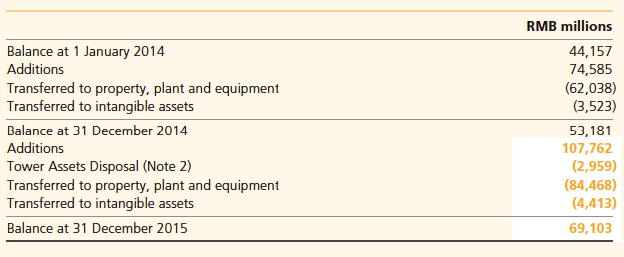
7. Goodwill

On 1 October 2008, the Group acquired the CDMA mobile communication business and related assets and liabilities, which also included the entire equity interests of China Unicom (Macau) Company Limited (currently known as China Telecom (Macau) Company Limited) and 99.5% equity interests of Unicom Huasheng Telecommunications Technology Company Limited (currently known as Tianyi Telecom Terminals Company Limited) (collectively the “CDMA business”) from China Unicom Limited and China Unicom Corporation Limited (collectively “China Unicom”). The purchase price of the business combination was RMB43,800 million, which was fully settled as at 31 December 2010. In addition, pursuant to the acquisition agreement, the Group acquired the customer-related assets and assumed the customer-related liabilities of CDMA business for a net settlement amount of RMB3,471 million due from China Unicom. This amount was subsequently settled by China Unicom in 2009. The business combination was accounted for using the purchase method.
The goodwill recognised in the business combination is attributable to the skills and technical talent of the acquired business’s workforce, and the synergies expected to be achieved from integrating and combining the CDMA mobile communication business into the Group’s telecommunications business.
For the purpose of goodwill impairment testing, the goodwill arising from the acquisition of CDMA business was allocated to the appropriate cash-generating unit of the Group, which is the Group’s telecommunications business. The recoverable amount of the Group’s telecommunications business is estimated based on the value in use model, which considers the Group’s financial budgets covering a five-year period and a pre-tax discount rate of 9.7% (2014: 10.3%). Cash flows beyond the fiveyear period are projected to perpetuity at annual growth rate of 1.5%. Management performed impairment tests for the goodwill at the end of the reporting period and determined that goodwill was not impaired. Management believes any reasonably possible change in the key assumptions on which the recoverable amount is based would not cause its recoverable amount to be less than carrying amount.
Key assumptions used for the value in use calculation model are the number of subscribers, average revenue per subscriber and gross margin. Management determined the number of subscribers, average revenue per subscriber and gross margin based on historical trends and financial information and operational data.
8. Intangible Assets
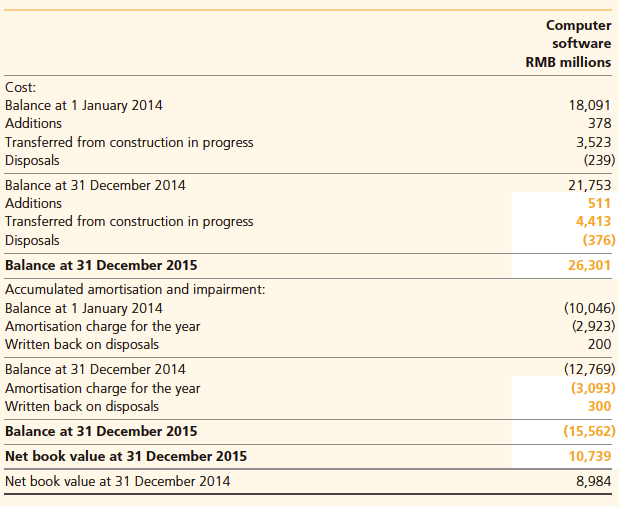
9. Investments in Subsidiaries
Details of the Company’s subsidiaries which principally affected the results, assets and liabilities of the Group at 31 December 2015 are as follows:
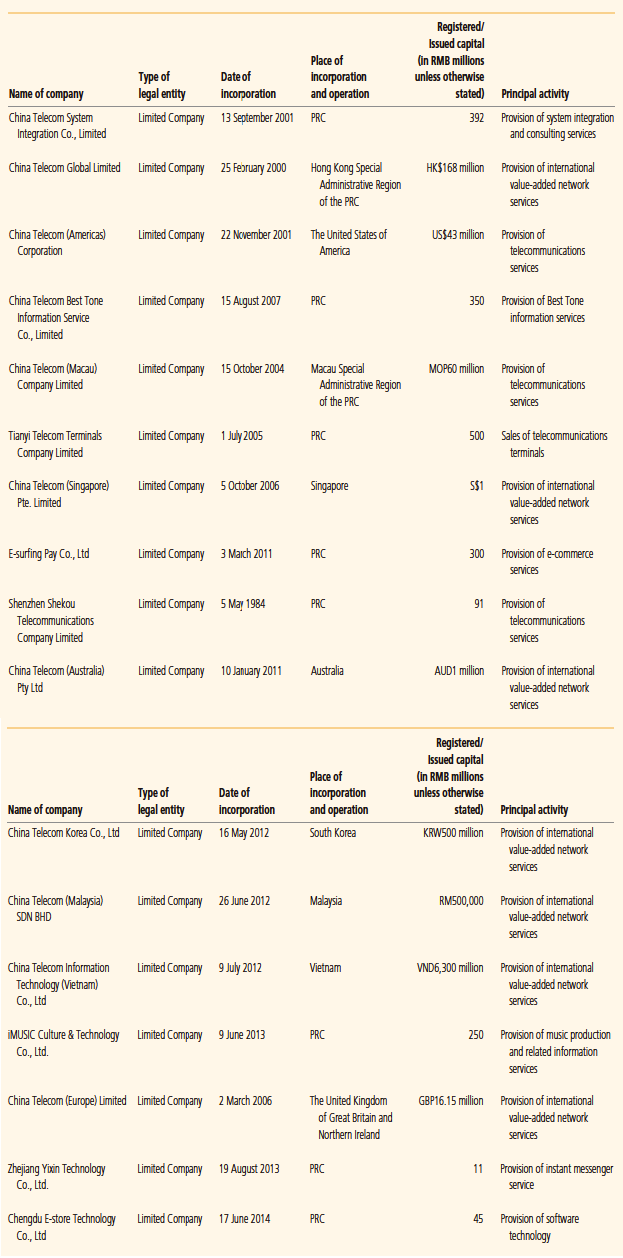
Except for Shenzhen Shekou Telecommunications Company Limited which is 51% owned by the Company and Zhejiang Yixin Technology Co., Ltd. which is 65% owned by the Company, all of the above subsidiaries are directly or indirectly wholly-owned by the Company. No subsidiaries of the Group have material non-controlling interest.
10. Interests in Associates

The Group’s interests in associates are accounted for under the equity method. Details of the Group’s principal associates are as follows:

The above associates are established in the PRC and are not traded on any stock exchange.
Summarised financial information of the Group’s principal associates and reconciled to the carrying amounts of interests in associates in the Group’s consolidated financial statements are disclosed below:
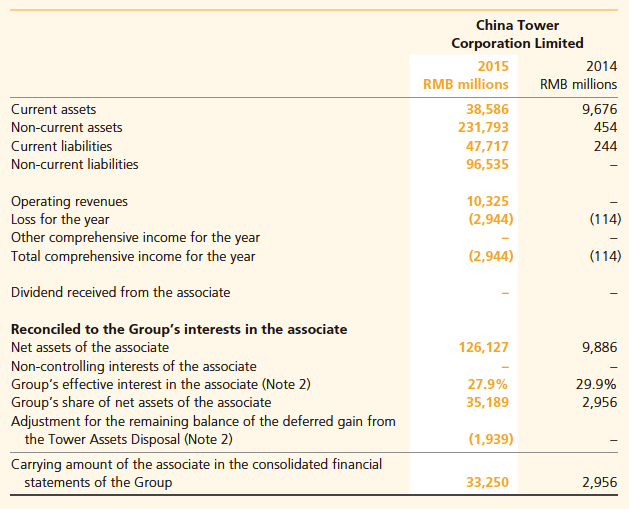
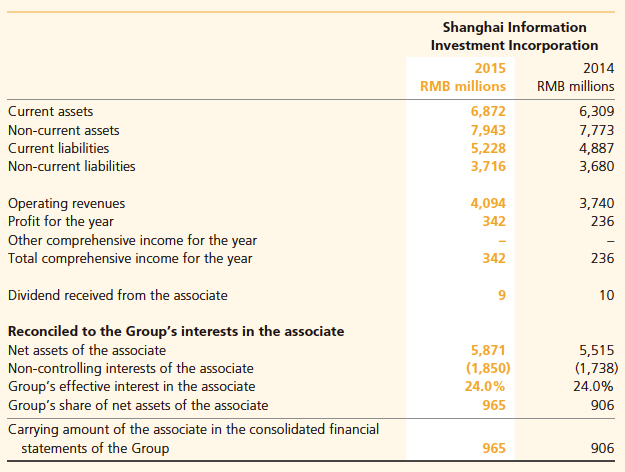
11. Investments

Other unlisted equity investments mainly represent the Group’s various interests in PRC private enterprises which are mainly engaged in the provision of information technology services and Internet contents.
12. Deferred Tax Assets and Liabilities
The components of deferred tax assets and deferred tax liabilities recognised in the consolidated statement of financial position and the movements are as follows:
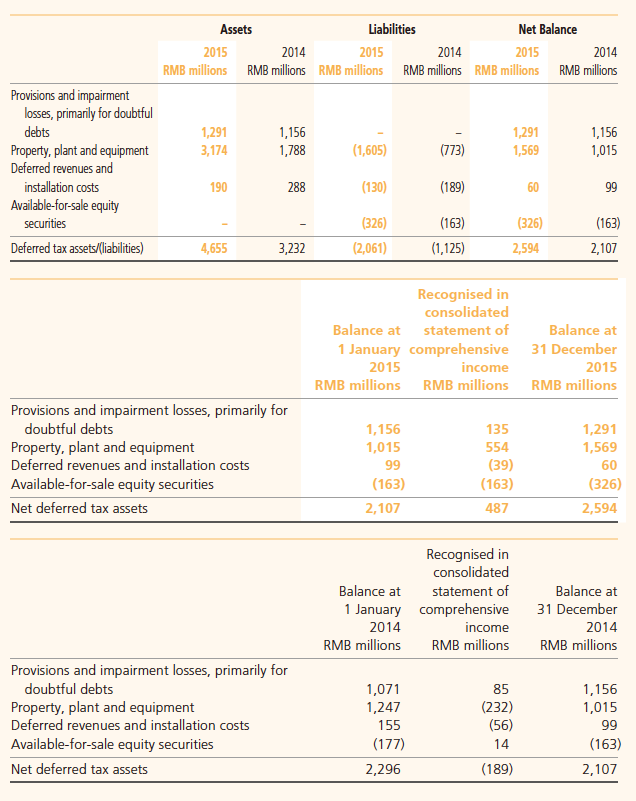
13. Inventories
Inventories represent:

14. Accounts Receivable, Net
Accounts receivable, net, are analysed as follows:

Note:
(i) China Telecommunications Corporation together with its subsidiaries other than the Group are referred to as “China Telecom Group”.
The following table summarises the changes in allowance for doubtful debts:

Ageing analysis of accounts receivable from telephone and Internet subscribers based on the billing dates is as follows:

Ageing analysis of accounts receivable from other telecommunications operators and enterprise customers based on date of rendering of services is as follows:
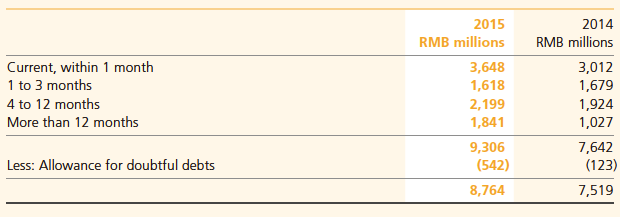
Ageing analysis of accounts receivable that are not impaired is as follows:

15. Prepayments and Other Current Assets
Prepayments and other current assets represent:

16. Cash and Cash Equivalents

17. Short-Term and Long-Term Debt and Payable
Short-term debt comprises:

The weighted average interest rate of the Group’s total short-term debt as at 31 December 2015 was 3.1% (2014: 5.1%) per annum. As at 31 December 2015, the Group’s loans from banks and other loans bear interest at rates ranging from 3.9% to 5.6% (2014: 4.5% to 11.0%) per annum, and are repayable within one year; as at 31 December 2015, super short-term commercial papers bear interest at rates ranging from 2.1% to 3.0% (2014: 5.3% to 5.6%) per annum and were fully repaid by March 2016; the loans from China Telecom Group bear interest at rates from 3.5% to 4.5% (2014: 4.5%) per annum and are repayable within one year.
Long-term debt and payable comprises:

Note:
(i) The Group obtained long-term RMB denominated government loans with below-market interest rate ranging from 1.08% to 1.20% per annum through banks, and recognised the loans at their fair value on initial recognition, and accreted the discount to profit or loss using the effective interest rate method. The difference between the fair value and face value of the loans was recognised as government grants in deferred revenue (Note 20).
(ii) Represents the remaining balance of the deferred consideration payable to China Telecommunications Corporation in respect of the acquisition of certain CDMA network assets and associated liabilities, which were held by China Telecommunications Corporation through network branches located in 30 provinces, municipalities and autonomous regions in the PRC (hereinafter referred to as the “Mobile Network Acquisition”). The Company may, from time to time, pay all or part of the deferred payment at any time after the completion date without penalty until the fifth anniversary of the completion date of the Mobile Network Acquisition. The Company pays interest on the deferred payment to China Telecommunications Corporation at half-yearly intervals and the interest accrues from the day following the completion of the Mobile Network Acquisition. The interest rate is set at a 5 basis points premium to the yield of the 5-year super AAA rated Medium Term Notes most recently published by the National Association of Financial Market Institutional Investors before the completion date of the Mobile Network Acquisition and will be adjusted once a year in accordance with the last yield of the 5-year super AAA rated Medium Term Notes most recently published by the National Association of Financial Market Institutional Investors at the end of each year. The interest rates for 2015 and 2016 are 5.11% and 4.00%, respectively.
If the amount is not paid when due, the Company is required to pay the liquidated damages on such amount at a daily rate of 0.03% of the amount in arrears from the day following the applicable due date to the date that such amount has actually been paid in full.
The aggregate maturities of the Group’s long-term debt and payable subsequent to 31 December 2015 are as follows:
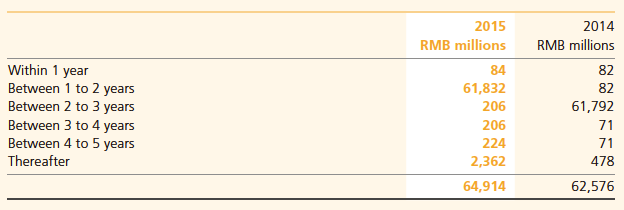
The Group’s short-term and long-term debt and payable do not contain any financial covenants. As at 31 December 2015, the Group had unutilised committed credit facilities amounting to RMB128,839 million (2014: RMB130,488 million).
18. Cash and Cash Equivalents
Accounts payable are analysed as follows:

Amounts due to China Telecom Group are payable in accordance with contractual terms which are similar to those terms offered by third parties.
Ageing analysis of accounts payable based on the due date is as follows:

19. Accrued Expenses and Other Payables
Accrued expenses and other payables represent:
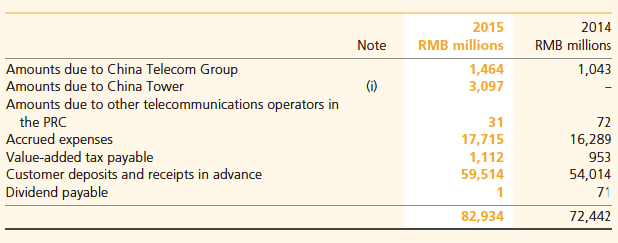
Note:
(i) The amounts due to China Tower as at 31 December 2015 includes the cash injection amounting to RMB2,966 million pursuant to the Transfer Agreement. The amount was paid in February 2016.
20. Deferred Revenues
Deferred revenues mainly represent the unearned portion of installation fees for wireline services received from customers, the unused portion of calling cards, and the unamortised portion of government grants (Note 17).
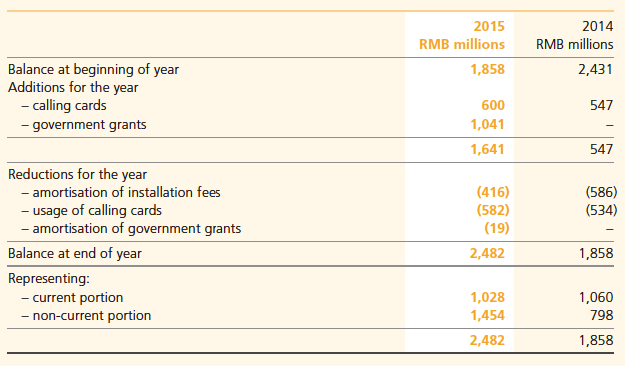
Included in other assets are primarily capitalised direct costs associated with the installation of wireline services. As at 31 December 2015, the unamortised portion of these costs was RMB560 million (2014: RMB818 million).
21. Share Capital

All ordinary domestic shares and H shares rank pari passu in all material respects.
22. Reserves
The Group
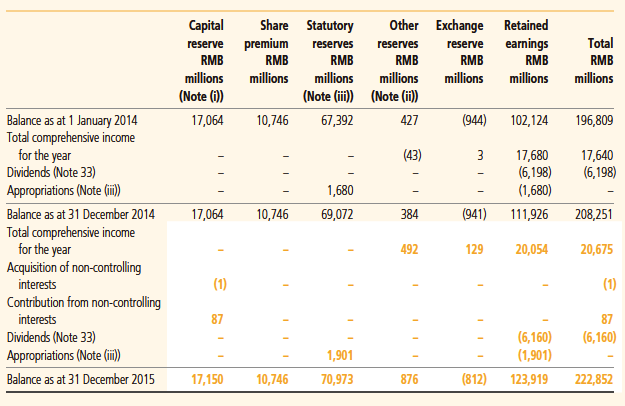
The Company
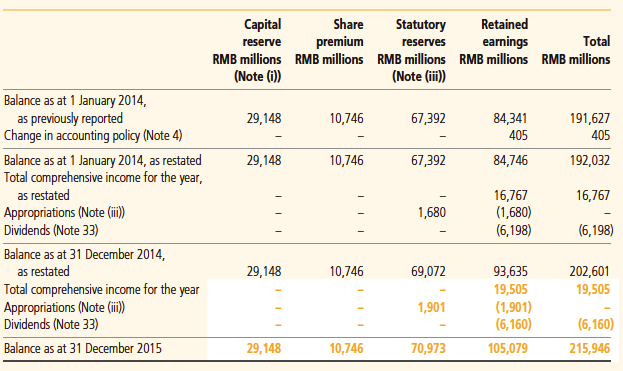
Note:
(i) Capital reserve of the Group mainly represents the sum of (a) the difference between the carrying amount of the Company’s net assets and the par value of the Company’s shares issued upon its formation; and (b) the difference between the consideration paid by the Group for the entities acquired, other than the Fifth Acquired Group, from China Telecommunications Corporation as described in Note 1, which were accounted for as equity transactions as disclosed in Note 1 to the consolidated financial statements, and the historical carrying amount of the net assets of these acquired entities.
The difference between the consideration paid by the Group and the historical carrying amount of the net assets of the Fifth Acquisition was recorded as a deduction of retained earnings.
Capital reserve of the Company represents the difference between the carrying amount of the Company’s net assets and the par value of the Company’s shares issued upon its formation.
(ii) Other reserves of the Group represent primarily the change in the fair value of available-for-sale equity securities and the deferred tax liabilities recognised due to the change in fair value of available-for-sale equity securities.
(iii) The statutory reserves consist of statutory surplus reserve and discretionary surplus reserve.
According to the Company’s Articles of Association, the Company is required to transfer 10% of its net profit, as determined in accordance with the lower of the amount determined under the PRC Accounting Standards for Business Enterprises and the amount determined under IFRS, to the statutory surplus reserve until such reserve balance reaches 50% of the registered capital. The transfer to this reserve must be made before distribution of any dividend to shareholders. For the year ended 31 December 2015, the net profit of the Company determined in accordance with the PRC Accounting Standards for Business Enterprises and IFRS are the same. For the year ended 31 December 2015, the Company transferred RMB1,901 million, being 10% of the year’s net profit, to this reserve. For the year ended 31 December 2014, the Company transferred RMB1,680 million, being 10% of the year’s net profit determined in accordance with the IFRS.
The Company did not transfer any discretionary surplus reserve for the years ended 31 December 2015 and 2014.
The statutory and discretionary surplus reserves are non-distributable other than in liquidation and can be used to make good of previous years’ losses, if any, and may be utilised for business expansion or converted into share capital by issuing new shares to existing shareholders in proportion to their shareholdings or by increasing the par value of the shares currently held by them, provided that the remaining reserve balance after such issue is not less than 25% of the registered capital.
(iv) According to the Company’s Articles of Association, the amount of retained earnings available for distribution to shareholders of the Company is the lower of the amount of the Company’s retained earnings determined in accordance with the PRC Accounting Standards for Business Enterprises and the amount determined in accordance with IFRS. As at 31 December 2015, the amount of retained earnings available for distribution was RMB105,079 million (2014: RMB93,635 million), being the amount determined in accordance with IFRS. Final dividend of approximately RMB6,461 million in respect of the financial year 2015 proposed after the end of the reporting period has not been recognised as a liability in the consolidated financial statements at the end of the reporting period (Note 33).
23. Operating Revenues
Operating revenues represent revenues from the provision of telecommunications services. The components of the Group’s operating revenues are as follows:

Note:
Before 1 June 2014, most of the Group’s operating revenues were subject to business tax levied at rates of 3%, relevant business tax was set off against operating revenues. Pursuant to the Notice on Covering Telecommunications Industries under the VAT Reform (Caishui [2014] No. 43) jointly issued by the Ministry of Finance and the State Administration of Taxation, from 1 June 2014, the pilot programme of replacing business tax with VAT is extended to cover the telecommunications industry. VAT is excluded from operating revenues. With effect from 1 June 2014, the Group is no longer required to pay business tax of 3% on telecommunications services.
(i) Represent the aggregate amount of monthly fees, local usage fees, domestic long distance usage fees, international, Hong Kong, Macau and Taiwan long distance usage fees, interconnections fees and installation fees charged to customers for the provision of wireline telephony services.
(ii) Represent the aggregate amount of monthly fees, local usage fees, domestic long distance usage fees, international, Hong Kong, Macau and Taiwan long distance usage fees and interconnections fees charged to customers for the provision of mobile telephony services.
(iii) Represent amounts charged to customers for the provision of Internet access services.
(iv) Represent the aggregate amount of fees charged to customers for the provision of value-added services, which comprise primarily caller ID services, short messaging services, Colour Ring Tone, Internet data centre and Virtual Private Network services and etc.
(v) Represent primarily the aggregate amount of fees charged to customers for Best Tone information services and IT services and applications.
(vi) Represent primarily the aggregate amount of fees charged to customers for the provision of telecommunications network resource services and lease income from other domestic telecommunications operators and enterprise customers for the usage of the Group’s telecommunications networks and equipment.
(vii) Represent primarily revenue from sale, and repair and maintenance of equipment as well as the resale of mobile services (MVNO).
24. Network Operations and Support Expenses
Included in the Group’s network operations and support expenses are as follows:

25. Personnel Expenses
Personnel expenses are attributable to the following functions:

26. Other Operating Expenses
Other operating expenses consist of:

Note:
(i) Interconnection charges represent amounts incurred for the use of other domestic and foreign telecommunications operators’ networks for delivery of voice and data traffic that originate from the Group’s telecommunications networks.
(ii) Cost of goods sold primarily represents cost of telecommunications equipment sold.
(iii) Others mainly include other surcharges related to VAT.
27. Total Operating Expenses
Total operating expenses for the year ended 31 December 2015 were RMB304,760 million (2014: RMB295,886 million) which include auditor’s remuneration in relation to audit and non-audit services (excluding value-added tax) of RMB65 million and RMB2 million respectively (2014: RMB62 million and RMB6 million).
28. Net Finance Costs
Net finance costs comprise:
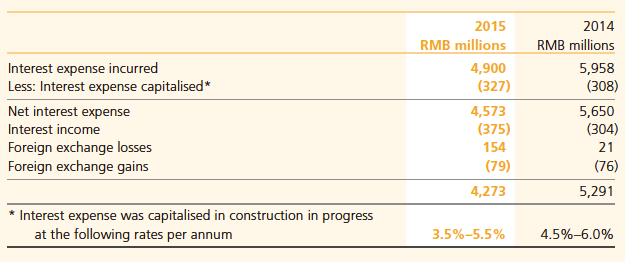
29. Income Tax
Income tax in the profit or loss comprises:

A reconciliation of the expected tax expense with the actual tax expense is as follows:
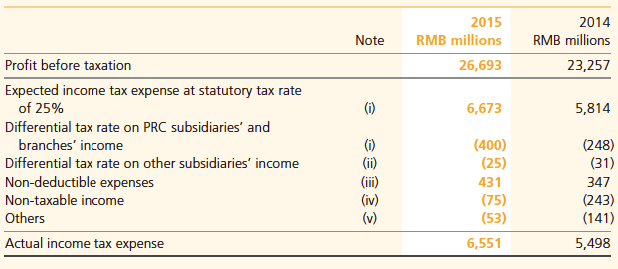
Note:
(i) Except for certain subsidiaries and branches which are mainly taxed at a preferential rate of 15%, the provision for mainland China income tax is based on a statutory rate of 25% of the assessable income of the Company, its mainland China subsidiaries and branches as determined in accordance with the relevant income tax rules and regulations of the PRC.
(ii) Income tax provisions of the Company’s subsidiaries in Hong Kong and Macau Special Administrative Regions of the PRC, and in other countries are based on the subsidiaries’ assessable income and income tax rates applicable in the respective tax jurisdictions which range from 12% to 38%.
(iii) Amounts represent miscellaneous expenses in excess of statutory deductible limits for tax purposes.
(iv) Amounts represent miscellaneous income which are not subject to income tax.
(v) Amounts primarily represent tax deduction on prior year research and development expenses, losses on disposal of property, plant and equipment approved by tax authorities and other tax benefits.
30. Directors’ and Supervisors’ Remuneration
The following table sets out the remuneration of the Company’s Directors and Supervisors:
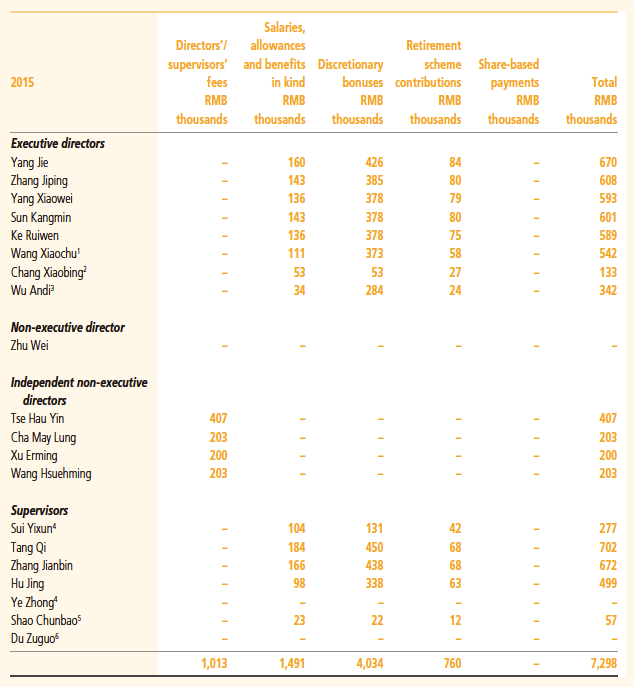
1. Mr. Wang Xiaochu resigned as an executive director of the Company on 24 August 2015.
2. Mr. Chang Xiaobing was appointed as an executive director of the Company on 23 October 2015 and resigned as an executive director of the Company on 30 December 2015.
3. Madam Wu Andi retired as an executive director of the Company on 10 February 2015.
4. Mr. Sui Yixun and Mr. Ye Zhong was appointed as supervisors of the Company on 27 May 2015.
5. Mr. Shao Chunbao resigned as a supervisor of the Company on 18 February 2015.
6. Mr. Du Zuguo resigned as a supervisor of the Company on 12 March 2015.
7. The independent non-executive directors’ remuneration were for their services as directors of the Company.
8. The remuneration of all Directors and Supervisors were calculated based on their respective actual terms of office within this year.
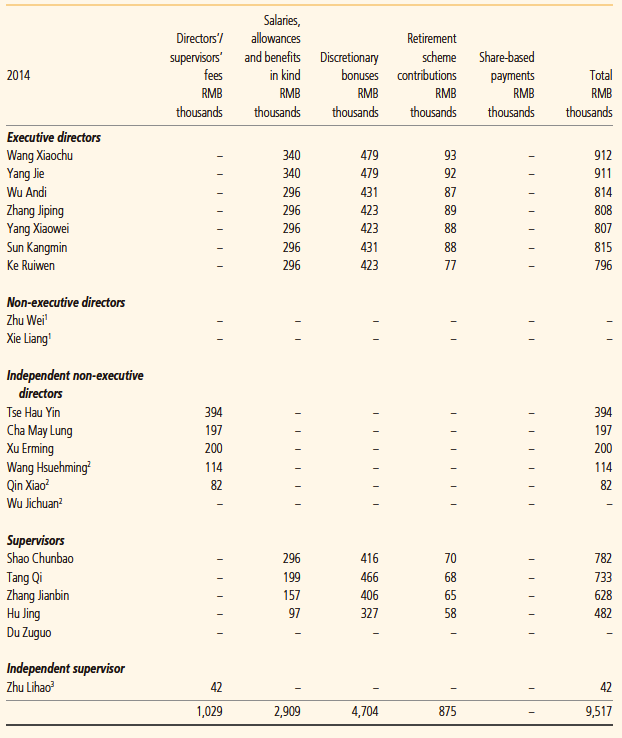
1 Mr. Xie Liang retired as a Non-executive Director of the Company on 29 May 2014. Mr. Zhu Wei was appointed as a Nonexecutive Director of the Company on 29 May 2014.
2 Mr. Qin Xiao and Mr. Wu Jichuan retired as Independent Non-executive Directors of the Company on 29 May 2014. Madam Wang Hsuehming was appointed as an Independent Non-executive Director of the Company on 29 May 2014.
3 Madam Zhu Lihao retired as an independent supervisor of the Company on 29 May 2014.
4 The independent non-executive directors’ remuneration were for their services as directors of the Company.
5 The remuneration of all Directors and Supervisors were calculated based on their respective actual terms of office within this year.
31. Individuals With Highest Emoluments and Senior Management Remuneration
(a) Five highest paid individuals
None of the five highest paid individuals of the Group for the year ended 31 December 2015 and 2014 were directors of the Company.
The aggregate of the emoluments in respect of the five (2014: five) individuals (non-directors) are as follows:

The emoluments of the five (2014: five) individuals (non-directors) with the highest emoluments are within the following bands:

None of these employees received any inducements or compensation for loss of office, or waived any emoluments during the periods presented.
(b) Senior management remuneration
The emoluments of the Group’s senior management are within the following bands:

32. Profit Attributable to Equity Holders of the Company
For the year ended 31 December 2015, the consolidated profit attributable to equity holders of the Company includes a profit of RMB19,013 million which has been dealt with in the stand-alone financial statements of the Company.
For the year ended 31 December 2014, the consolidated profit attributable to equity holders of the Company includes a profit of RMB16,810 million which has been dealt with in the stand-alone financial statements of the Company.
33. Dividends
Pursuant to a resolution passed at the Board of Directors’ meeting on 23 March 2016, a final dividend of equivalent to HK$0.095 per share totaling approximately RMB6,461 million for the year ended 31 December 2015 was proposed for shareholders’ approval at the annual general meeting. The dividend has not been provided for in the consolidated financial statements for the year ended 31 December 2015.
Pursuant to the shareholders’ approval at the annual general meeting held on 27 May 2015, a final dividend of RMB0.076120 (equivalent to HK$0.095) per share totaling RMB6,160 million in respect of the year ended 31 December 2014 was declared and paid on 17 July 2015.
Pursuant to the shareholders’ approval at the annual general meeting held on 29 May 2014, a final dividend of RMB0.076583 (equivalent to HK$0.095) per share totaling RMB6,198 million in respect of the year ended 31 December 2013 was declared and paid on 18 July 2014.
34. Basic Earnings Per Share
The calculation of basic earnings per share for the years ended 31 December 2015 and 2014 is based on the profit attributable to equity holders of the Company of RMB20,054 million and RMB17,680 million respectively, divided by 80,932,368,321 shares.
The amount of diluted earnings per share is not presented as there were no dilutive potential ordinary shares in existence for the periods presented.
35. Commitments and Contingencies
Operating lease commitments
The Group leases business premises and equipment through non-cancellable operating leases, and these operating leases do not contain provisions for contingent lease rentals. None of the rental agreements contain escalation provisions that may require higher future rental payments nor impose restrictions on dividends, additional debt and/or further leasing.
As at 31 December 2015 and 2014, the Group’s future minimum lease payments under noncancellable operating leases are as follows:

Total rental expense in respect of operating leases charged to profit or loss for the year ended 31 December 2015 was RMB10,331 million (2014: RMB7,779 million).
Capital commitments
As at 31 December 2015 and 2014, the Group had capital commitments as follows:

Contingent liabilities
(a) The Group was advised by their PRC lawyers that, no material contingent liabilities were assumed by the Group.
(b) As at 31 December 2015 and 2014, the Group did not have contingent liabilities in respect of guarantees given to banks in respect of banking facilities granted to other parties, or other forms of contingent liabilities.
Legal contingencies
The Group is a defendant in certain lawsuits as well as the named party in other proceedings arising in the ordinary course of business. Management has assessed the likelihood of an unfavourable outcome of such contingencies, lawsuits or other proceedings and based on such assessment, believes that any resulting liabilities will not have a material adverse effect on the financial position, operating results or cash flows of the Group.
36. Financial Instruments
Financial assets of the Group include cash and cash equivalents, bank deposits, investments, accounts receivable, prepayments and other receivables. Financial liabilities of the Group include short-term and long-term debt and payable, other non-current liabilities, accounts payable, accrued expenses and other payables. The Group does not hold nor issue financial instruments for trading purposes.
(a) Fair Value Measurements
Based on IFRS 13, Fair Value Measurement, the fair value of each financial instrument is categorised in its entirety based on the lowest level of input that is significant to that fair value measurement. The levels are defined as follows:
• Level 1: fair values measured using quoted prices (unadjusted) in active markets for identical financial instruments
• Level 2: fair values measured using quoted prices in active markets for similar financial instruments, or using valuation techniques in which all significant inputs are directly or indirectly based on observable market data
• Level 3: fair values measured using valuation techniques in which any significant input is not based on observable market data
The fair values of the Group’s financial instruments (other than long-term debt and payable, other non-current liabilities and available-for-sale equity investment securities) approximate their carrying amounts due to the short-term maturity of these instruments.
The Group’s available-for-sale equity investment securities are categorised as level 1 financial instruments. As at 31 December 2015, the fair value of the Group’s available-for-sale equity investment securities are RMB1,597 million (2014: RMB945 million), respectively, based on quoted market price on PRC stock exchanges. The Group’s long-term investments, other than the available-for-sale equity investment securities, are unlisted equity interests for which no quoted market prices exist in the PRC and because their fair values cannot be measured reliably, so their fair values were not disclosed.
The fair values of long-term debt and payable and other non-current liabilities are estimated by discounting future cash flows using current market interest rates offered to the Group for debt with substantially the same characteristics and maturities. The fair value measurement of longterm debt and payable and other non-current liabilities is categorised as level 2. The interest rates used by the Group in estimating the fair values of long-term debt and payable and other non-current liabilities, having considered the foreign currency denomination of the debt, ranged from 1.0% to 4.9% (2014: 1.0% to 6.6%). As at 31 December 2015 and 2014, the carrying amounts and fair values of the Group’s long-term debt and payable and other noncurrent liabilities were as follows:

During the year, there were no transfers among instruments in level 1, level 2 or level 3.
(b) Risks
The Group’s financial instruments are exposed to three main types of risks, namely, credit risk, liquidity risk and market risk (which comprises of interest rate risk and foreign currency exchange rate risk). The Group’s overall risk management programme focuses on the unpredictability of financial markets and seeks to minimise potential adverse effects on the Group’s financial performance. Risk management is carried out under policies approved by the Board of Directors. The Board provides principles for overall risk management, as well as policies covering specific areas, such as liquidity risk, credit risk, and market risk. The Board regularly reviews these policies and authorises changes if necessary based on operating and market conditions and other relevant risks. The following summarises the qualitative and quantitative disclosures for each of the three main types of risks:
(i) Credit risk
Credit risk refers to the risk that a counterparty will be unable to pay amounts in full
when due. For the Group, this arises mainly from deposits it maintains at financial
institutions and credit it provides to customers for the provision of telecommunications
services. To limit exposure to credit risk relating to deposits, the Group primarily
places cash deposits only with large state-owned financial institutions in the PRC with
acceptable credit ratings. For accounts receivable, management performs ongoing credit
evaluations of its customers’ financial condition and generally does not require collateral
on accounts receivable. Furthermore, the Group has a diversified base of customers with
no single customer contributing more than 10% of revenues for the periods presented.
Further details of the quantitative disclosures in respect of the Group’s exposure on credit
risk for accounts receivable are set out in Note 14.
(ii) Liquidity risk
Liquidity risk refers to the risk that funds will not be available to meet liabilities as they
fall due, and results from timing and amount mismatches of cash inflow and outflow.
The Group manages liquidity risk by maintaining sufficient cash balances and adequate
amount of committed banking facilities to meet its funding needs, including working
capital, principal and interest payments on debts, dividend payments, capital expenditures
and new investments for a set minimum period of between 3 to 6 months.
The following table sets out the remaining contractual maturities at the end of the reporting period of the Group’s financial liabilities, which are based on contractual undiscounted cash flows (including interest payments computed using contractual rates or, if floating, based on prevailing rates at the end of the reporting period) and the earliest date the Group would be required to repay:
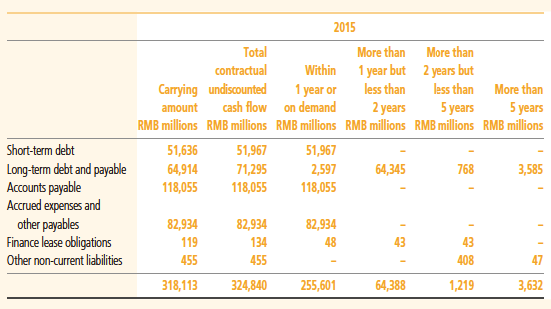
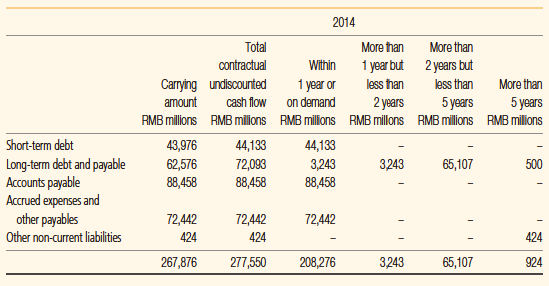
Management believes that the Group’s current cash on hand, expected cash flows from operations and available credit facilities from banks (Note 17) will be sufficient to meet the Group’s working capital requirements and repay its borrowings and obligations when they become due.
(iii) Interest rate risk
The Group’s interest rate risk exposure arises primarily from its short-term debt and longterm
debt and payable. Debts carrying interest at variable rates and at fixed rates expose
the Group to cash flow interest rate risk and fair value interest rate risk, respectively. The
Group manages its exposure to interest rate risk by closely monitoring the change in the
market interest rate.
The following table sets out the interest rate profile of the Group’s debt at the end of the reporting period:

As at 31 December 2015, it is estimated that an increase of 100 basis points in interest rate, with all other variables held constant, would decrease the Group’s net profit for the year and retained earnings by approximately RMB469 million (2014: RMB469 million).
The above sensitivity analysis has been prepared on the assumptions that the change of interest rate was applied to the Group’s debt in existence at the end of the reporting period with exposure to cash flow interest rate risk. The analysis is prepared on the same basis for 2014.
(iv) Foreign currency exchange rate risk
Foreign currency exchange rate risk arises on financial instruments that are denominated
in a currency other than the functional currency in which they are measured. The Group’s
foreign currency risk exposure relates to bank deposits and borrowings denominated
primarily in US dollars, Euros and Hong Kong dollars.
Management does not expect the appreciation or depreciation of the Renminbi against foreign currencies will materially affect the Group’s financial position and result of operations because 92.6% (2014: 93.1%) of the Group’s cash and cash equivalents and 99.4% (2014: 99.2%) of the Group’s short-term and long-term debt and payable as at 31 December 2015 are denominated in Renminbi. Details of bank loans denominated in other currencies are set out in Note 17.
37. Capital Management
The Group’s primary objectives when managing capital are to safeguard the Group’s ability to continue as a going concern, so that it can continue to provide investment returns for shareholders and benefits for other stakeholders, by pricing products and services commensurately with the level of risk and by securing access to finance at a reasonable cost.
Management regularly reviews and manages its capital structure to maintain a balance between the higher shareholder returns that might be possible with higher levels of borrowings and the advantages and security afforded by a sound capital position, and makes adjustments to the capital structure in light of changes in economic conditions.
Management monitors its capital structure on the basis of total debt-to-total assets ratio. For this purpose the Group defines total debt as the sum of short-term debt, long-term debt and payable, and finance lease obligations. As at 31 December 2015, the Group’s total debt-to-total assets ratio was 18.5% (2014: 19.0%), which is within the range of management’s expectation.
Neither the Company nor any of its subsidiaries are subject to externally imposed capital requirements.
38. Related Party Transactions
(a) Transactions with China Telecom Group
The Group is a part of companies under China Telecommunications Corporation, a company owned by the PRC government, and has significant transactions and business relationships with members of China Telecom Group.
The principal transactions with China Telecom Group are as follows. These transactions constitute continuing connected transactions under the Listing Rules and the Company has complied with the relevant disclosure requirements under Chapter 14A of the Listing Rules. Further details of these continuing connected transactions are disclosed under the paragraph “Connected Transactions” in the Report of Directors.

* These transactions are conducted on normal commercial terms and are fully exempted from compliance with the reporting, announcement, independent shareholders’ approval and/or annual review requirements either under Rules 14A.76 or 14A.90 of the Listing Rules.
Note:
(i) Represent the amount of telecommunications equipment and materials purchased from/sold to China Telecom Group and commission paid and payable for procurement services provided by China Telecom Group.
(ii) Represent construction and engineering as well as design and supervisory services provided by China Telecom Group.
(iii) Represent IT services provided to and received from China Telecom Group.
(iv) Represent amounts paid and payable to China Telecom Group in respect of cultural, educational, health care and other community services.
(v) Represent amounts paid and payable to China Telecom Group in respect of ancillary services such as repairs and maintenance of telecommunications equipment and facilities and certain customer services.
(vi) Represent amounts of property lease fee received and receivable from/paid and payable to China Telecom Group for mutual leasing of properties.
(vii) Represent net amount shared between the Company and China Telecom Group for costs associated with centralised services. The amount represents amounts received or receivable for the net amount of centralised services.
(viii) Represent amounts received and receivable from/paid and payable to China Telecom Group for interconnection of local and domestic long distance calls.
(ix) Represent amounts received and receivable from China Telecom Group in respect of Internet applications channel services, including the provision of telecommunications channel and applications support platform and billing and deduction services, etc.
(x) Represent interest paid and payable to China Telecom Group with respect to the amounts due to China Telecommunications Corporation and loans from China Telecom Group (Note 17).
(xi) Represent amounts paid and payable to China Telecom Group primarily for lease of certain CDMA mobile telecommunications network (“CDMA network”) facilities located in Xizang Autonomous Region.
(xii) Represent amounts paid and payable to China Telecom Group for lease of certain inter-provincial transmission optic fibres within its service regions.
(xiii) Represent amounts paid and payable to China Telecom Group for leases of land use rights.
Amounts due from/to China Telecom Group are summarised as follows:

Amounts due from/to China Telecom Group, other than short-term debt and long-term debt and payable, bear no interest, are unsecured and are repayable in accordance with contractual terms which are similar to those terms offered by third parties. The terms and conditions associated with short-term debt and long-term debt and payable due to China Telecom Group are set out in Note 17.
As at 31 December 2015 and 2014, no material allowance for doubtful debts was recognised in respect of amounts due from China Telecom Group.
(b) Transactions with China Tower
The principal transactions with China Tower are as follows:

Note:
(i) Represent amounts paid and payable to China Tower for the usage of telecommunications towers and related assets.
Amounts due from/to China Tower are summarised as follows:

Amounts due from/to China Tower bear no interest, are unsecured and are repayable in accordance with contractual terms which are similar to those terms offered by third parties.
As at 31 December 2015 and 2014, no material allowance for doubtful debts was recognised in respect of amounts due from China Tower.
(c) Key management personnel compensation
Key management personnel are those persons having authority and responsibility for planning, directing and controlling the activities of the Group, directly or indirectly, including directors and supervisors of the Group.
Key management personnel compensation of the Group is summarised as follows:

The above remuneration is included in personnel expenses.
(d) Contributions to post-employment benefit plans
The Group participates in various defined contribution post-employment benefit plans organised by municipal, autonomous regional and provincial governments for its employees. Further details of the Group’s post-employment benefit plans are disclosed in Note 40.
(e) Transactions with other government-related entities in the PRC
The Group is a government-related enterprise and operates in an economic regime currently dominated by entities directly or indirectly controlled by the People’s Republic of China through government authorities, agencies, affiliations and other organisations (collectively referred to as “government-related entities”).
Apart from transactions with parent company and its fellow subsidiaries (Note 38(a)), the Group has transactions that are collectively but not individually significant with other government-related entities, which include but not limited to the following:
– rendering and receiving services, including but not limited to telecommunications services
– sales and purchases of goods, properties and other assets
– lease of assets
– depositing and borrowing
– use of public utilities
These transactions are conducted in the ordinary course of the Group’s business on terms comparable to the terms of transactions with other entities that are not government-related. The Group prices its telecommunications services and products based on governmentregulated tariff rates, where applicable, or based on commercial negotiations. The Group has also established procurement policies and approval processes for purchases of products and services, which do not depend on whether the counterparties are government-related entities or not.
The directors of the Company believe the above information provides appropriate disclosure of related party transactions.
39. Information About the Statement of Financial Position of the Company
Information about the statement of financial position of the Company at the end of the reporting period includes:
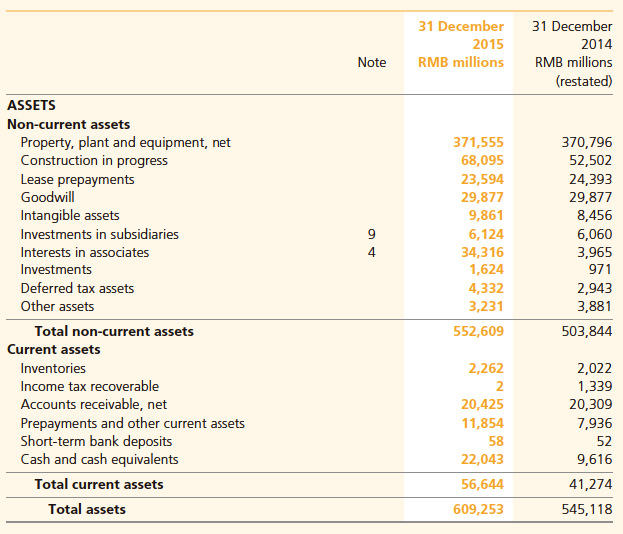

40. Post-Employment Benefits Plans
As stipulated by the regulations of the PRC, the Group participates in various defined contribution retirement plans organised by municipal, autonomous regional and provincial governments for its employees. The Group is required to make contributions to the retirement plans at rates ranging from 14% to 21% of the salaries, bonuses and certain allowances of the employees. A member of the plan is entitled to a pension equal to a fixed proportion of the salary prevailing at the member’s retirement date. Other than the above, the Group also participates in supplementary defined contribution retirement plans managed by independent external parties whereby the Group is required to make contributions to the retirement plans at fixed rates of the employees’ salaries, bonuses and certain allowances. The Group has no other material obligation for the payment of pension benefits associated with these plans beyond the annual contributions described above.
The Group’s contributions for the above plans for the year ended 31 December 2015 were RMB6,584 million (2014: RMB6,229 million).
The amount payable for contributions to the above defined contribution retirement plans as at 31 December 2015 was RMB791 million (2014: RMB669 million)
41. Stock Appreciation Rights
The Group implemented a stock appreciation rights plan for members of its management to provide incentives to these employees. Under this plan, stock appreciation rights are granted in units with each unit representing one H share. No shares will be issued under the stock appreciation rights plan. Upon exercise of the stock appreciation rights, a recipient will receive, subject to any applicable withholding tax, a cash payment in RMB, translated from the Hong Kong dollar amount equal to the product of the number of stock appreciation rights exercised and the difference between the exercise price and market price of the Company’s H shares at the date of exercise based on the applicable exchange rate between RMB and Hong Kong dollar at the date of the exercise. The Company recognises compensation expense of the stock appreciation rights over the applicable vesting period.
In 2012, the Company approved the granting of 916.7 million stock appreciation right units to eligible employees. Under the terms of this grant, all stock appreciation rights had a contractual life of five years from date of grant and an exercise price of HK$4.76 per unit. A recipient of stock appreciation rights may exercise the rights in stages commencing November 2013. As at each of the third, fourth and fifth anniversary of the date of grant, the total number of stock appreciation rights exercisable may not in aggregate exceed 33.3%, 66.7% and 100%, respectively, of the total stock appreciation rights granted to such person.
During the year ended 31 December 2015 and 2014, no stock appreciation right units were exercised. For the year ended 31 December 2015, compensation expense of RMB102 million was reversed by the Group in respect of stock appreciation rights as a result of decline in share price of the Company. For the year ended 31 December 2014, compensation expense of RMB130 million was recognised by the Group in respect of stock appreciation rights.
As at 31 December 2015, the carrying amount of the liability arising from stock appreciation rights was RMB152 million (2014: RMB254 million). As at 31 December 2015, 908 million stock appreciation right units vested but were not exercised, and 8.7 million stock appreciation right units were forfeited. The carrying amount of the corresponding liability was RMB152 million. As at 31 December 2014, 609 million stock appreciation right units vested but were not exercised. The carrying amount of the corresponding liability was RMB183 million.
42. Accounting Estimates and Judgements
The Group’s financial position and results of operations are sensitive to accounting methods, assumptions and estimates that underlie the preparation of the consolidated financial statements. Management bases the assumptions and estimates on historical experience and on other factors that the management believes to be reasonable and which form the basis for making judgements about matters that are not readily apparent from other sources. On an on-going basis, management evaluates its estimates. Actual results may differ from those estimates as facts, circumstances and conditions change.
The selection of significant accounting policies, the judgements and other uncertainties affecting application of those policies and the sensitivity of reported results to changes in conditions and assumptions are factors to be considered when reviewing the consolidated financial statements. The significant accounting policies are set forth in Note 3. Management believes the following significant accounting policies involve the most significant judgements and estimates used in the preparation of the consolidated financial statements.
Allowance for doubtful debts
Management estimates an allowance for doubtful debts resulting from the inability of the customers to make the required payments. Management bases its estimates on the ageing of the accounts receivable balance, customer credit-worthiness, and historical write-off experience. If the financial condition of the customers were to deteriorate, actual write-offs might be higher than expected and could significantly affect the results of future periods.
Impairment of long-lived assets
If circumstances indicate that the carrying amount of a long-lived asset may not be recoverable, the asset may be considered “impaired”, and an impairment loss would be recognised in accordance with accounting policy for impairment of long-lived assets as described in Note 3(n). The carrying amounts of the Group’s long-lived assets, including property, plant and equipment, intangible assets with finite useful lives and construction in progress are reviewed periodically to determine whether there is any indication of impairment. These assets are tested for impairment whenever events or changes in circumstances indicate that their recorded carrying amounts may not be recoverable. For goodwill, the impairment testing is performed annually at the end of each reporting period. The recoverable amount of an asset or cash-generating unit is the greater of its value in use and fair value less costs of disposal. When an asset does not generate cash flows largely independent of those from other assets, the recoverable amount is determined for the smallest group of assets that generates cash inflows independently (i.e. a cash-generating unit). In determining the value in use, expected future cash flows generated by the assets are discounted to their present value. An impairment loss is recognised if the carrying amount of an asset or its cash-generating unit exceeds its estimated recoverable amount. It is difficult to precisely estimate fair value of the Group’s longlived assets because quoted market prices for such assets may not be readily available. In determining the value in use, expected future cash flows generated by the asset are discounted to their present value, which requires significant judgement relating to level of revenue, amount of operating costs and applicable discount rate. Management uses all readily available information in determining an amount that is a reasonable approximation of recoverable amount, including estimates based on reasonable and supportable assumptions and projections of revenue and amount of operating costs.
For the year ended 31 December 2015, provision for impairment losses of RMB51 million were made against the carrying value of long-lived assets (2014 Nil). In determining the recoverable amount of these equipment, significant judgments were required in estimating future cash flows, level of revenue, amount of operating costs and applicable discount rate.
Changes in these estimates could have a significant impact on the carrying value of the assets and could result in additional impairment charge or reversal of impairment in future periods.
Depreciation and amortisation
Property, plant and equipment and intangible assets are depreciated and amortised on a straight-line basis over the estimated useful lives of the assets, after taking into account their estimated residual value. Management reviews the estimated useful lives and residual values of the assets annually in order to determine the amount of depreciation and amortisation expense to be recorded during any reporting period. The useful lives and residual values are based on the Group’s historical experience with similar assets and take into account anticipated technological changes. The depreciation and amortisation expense for future periods is adjusted if there are significant changes from previous estimates.
43. Possible Impact of Amendments and New Standards Issued But Not Yet Effective for the Annual Accounting Period Ended 31 December 2015
Up to the date of issue of the consolidated financial statements, the IASB has issued the following amendments and new standards which are not yet effective and not early adopted for the annual accounting period ended 31 December 2015:
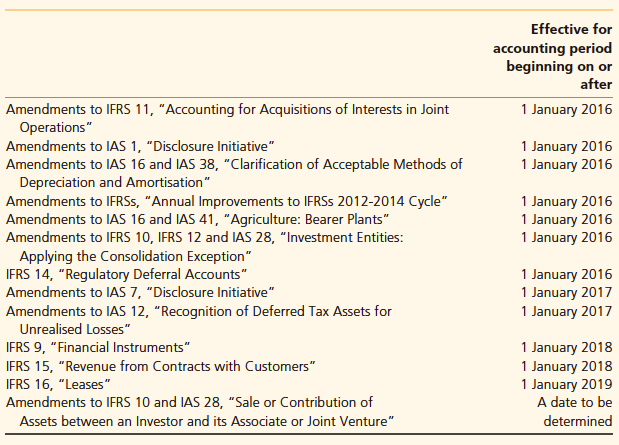
The Group is in the process of making an assessment of the impact that will result from adopting the amendments and new standards issued by the IASB which are not yet effective for the accounting period ended on 31 December 2015. Except for IFRS 15, “Revenue from Contracts with Customers”, and IFRS 16, “Leases”, so far the Group believes that the adoption of these amendments and new standards is unlikely to have a significant impact on its financial position and the results of operations.
44. Parent and Ultimate Holding Company
The parent and ultimate holding company of the Group as at 31 December 2015 is China Telecommunications Corporation, a state-owned enterprise established in the PRC.